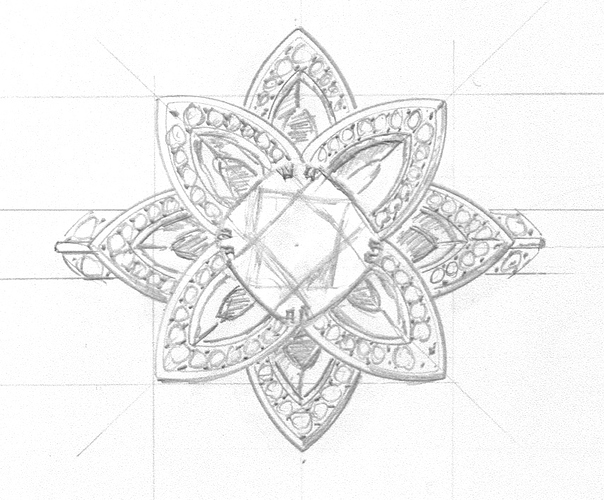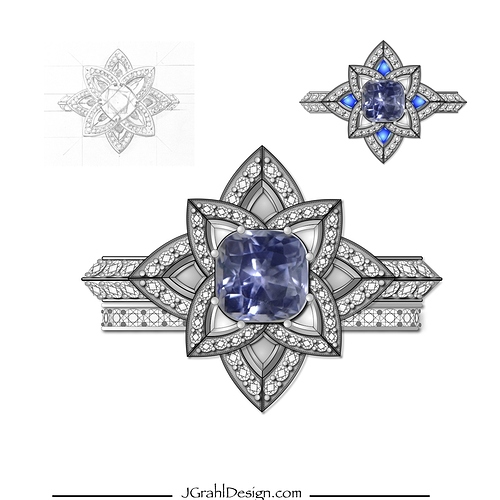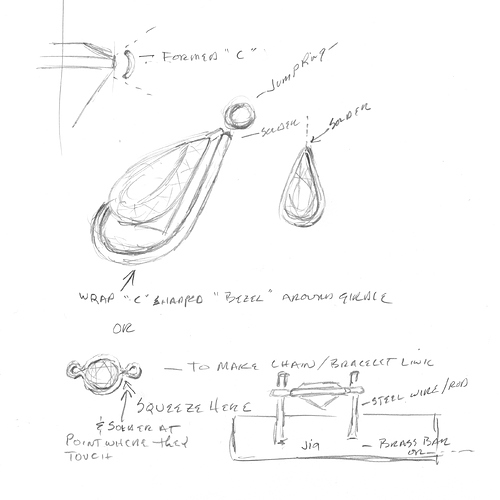Just fantastic drawings. Your attention to detail in these is superb. . . shading each pearl, the leaves in the #5 trillion pendant, the symmetry in the fleur-de-dis. It really is an art unto itself and one that I think is rapidly being lost with all the CAD generated images. Nothing against CAD, but there’s a palpable sense of artistry in these drawings that a digitally rendered image seems coldy devoid of. Wonderful work!
Here is kind of a melange lot, from monogram to bench sketches.
Sometimes it’s communicating with another, sometimes, just getting it out of my head.
Enjoy,
Jim
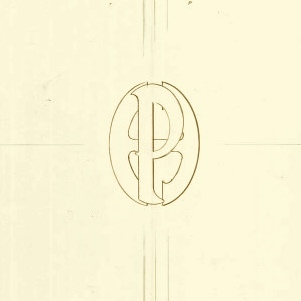
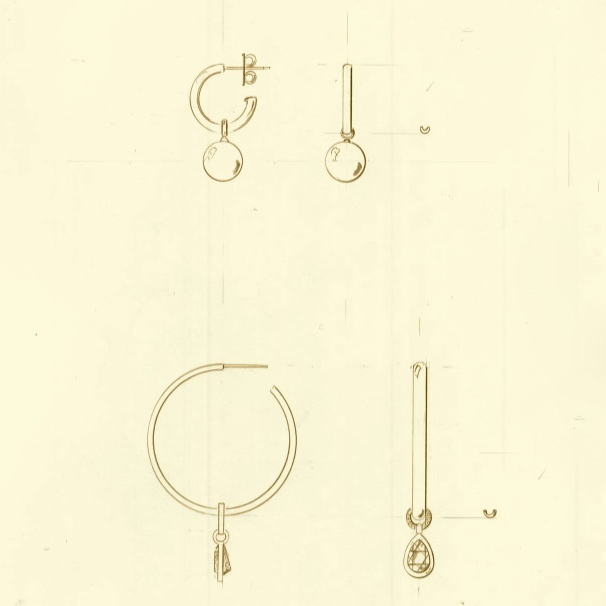
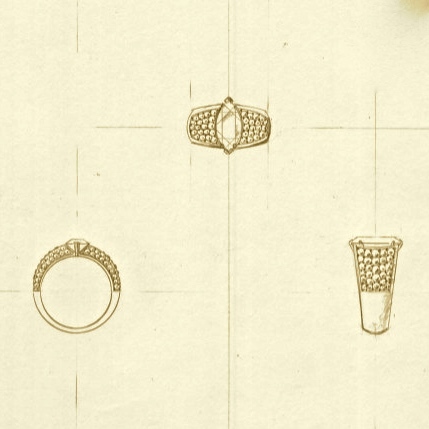
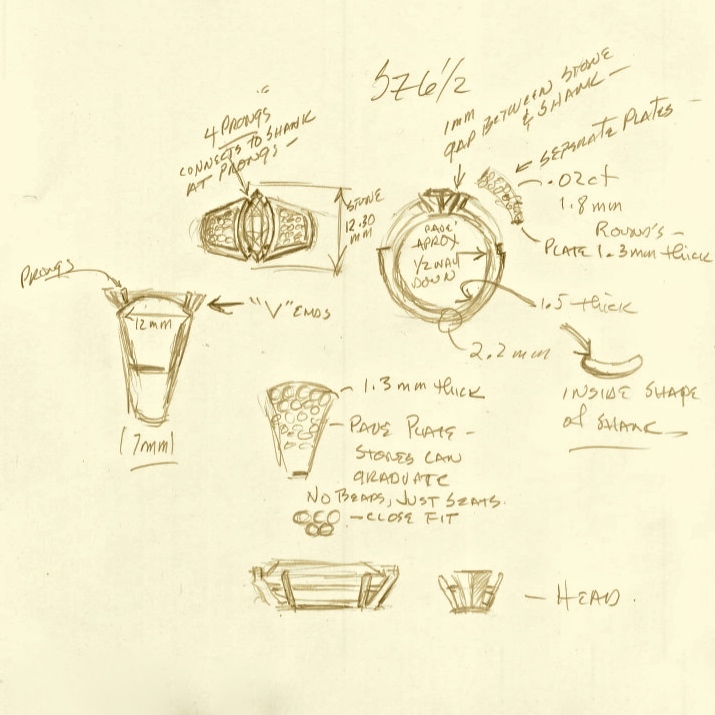
Is there a name for the stone setting on the lower earring drawing?
Hi Betty,
That is made with concave wire & wrapped around the girdle, the wire has a “C” cross section.
They were diamonds at the base so I could solder them, along with a ring, on.
Thanks, jim
Do you also use prongs with that setting?
Hi
No prongs,
It catches the girdle from both sides…
J
Can you send me just the “earring pattern”, such a large collection to
scroll through…=> gerrylewy18@gmail.com<=
Gerry Lewy
Hi Gerry,
Is this what you were asking about?
Otherwise I’ll do as needed tomorrow morning when I hit the shop.
This is a lousy graphic.
Thanks, Jim

Tough & rough design to name, it appears to be a semi-bezel. Any wrapping
around the girdle COULD be a Bezel shape!
Gerry Lewy
Hi Gerry,
I’ll do a better sketch tomorrow.
Thanks, Jim
It looks like a tight fit and the stone snaps into place, but are the edges of the concave wire pressed against the stone similar to setting a stone in a bezel?
Or is it the strength of the metal, such as using only platinum, that makes this setting secure without the need to press it against the stone?
Thanks for sharing these drawings! I love how clean and crisp it all looks. I wish I could draft out my designs half this well. Out of curiosity, about how long does it take you to do a pencil drawing like these? One of my biggest gripes when taking on custom projects is that I want to present the designs to my client in a clear and pleasing way such as these, but honestly, I might as well make the project twice for as long as it takes me to draft anything even half this nice. I have the hardest time balancing giving them a good idea of what I will make for them with not wanting them to have to essentially pay more than they should just for me to spend all this time drawing it up. How do you balance this or do your clients (given the nature of these designs) simply pay enough that it doesn’t really matter?
Thanks again!
Erich
Hi,
Two answers here,
Erich, These could take from 15 min. to several hours.
I build the drawings into the price because they become my blueprint.
They also give me the time to think my construction through.
As I’m drawing, I’m mentally building the piece (I generally won’t draw something I can’t build… The Escher Syndrome…),
I also highly recommend the “Autodesk Graphic program”, super cheap & kind of like a dumbed down Adobe Illustrator. Mac only so far.
There will be two Pictures below on a hand sketch, & my Graphic version. It’s still hand drawn, but with the advantage of tools for checking alignment & scale.
I photograph the client’s stone,
drop it in along with inner and outer ring size & outside diameter math & build from there.
More on that if needed.
Gerry & Betty,
here is a very rough sketch,
Essentially form a “C” out of thin , flat wire (or draw 1/2 round through a draw plate, there are other ways too…
Allow for extra material, wrap the stone (this is only for stones that take heat, or for use with a laser) solder the end closed
Make sure the wire is very thoroughly annealed.
Use small round nose pliers to pinch the ends together so the stone is trapped.
This is a very old method, goes back several thousand years, Where I might solder the end, another might just wrap it off with thin wire.
I get to a real illustration in time , but for right now , the one below might help a bit.
This is also used in the “Diamonds by the Yard” style of change work. Works best with fill rose cuts…
Thanks, Jim
Thanks for the reply and help Jim. If you don’t mind me prying a bit deeper, when it comes to your more elaborate sketches, is there a threshold in pricing that you use that for or is it for any custom project? Where I fall down on this stuff is the difference between sketching out an idea that is good enough to get the point across vs. a more “presentation-style” colored artwork such as some of the designs you’ve posted. Perhaps a better question would be, do you have an approximate percentage that you use for custom projects to dedicate to that level of drawing (i.e. X% of the custom cost is in design and drawings. I realize that for significant pieces in the 5 figure+ range it becomes a moot point, but where I’m stuck is in custom work that falls in the $2000-5000 range. It’s a weird spot to be in. People really want to maximize what they can get (naturally), but can also expect a level of detail and service as though they’re buying a new car. It’s actually getting to the point that I think I may stop taking on any more custom work. . . . it’s just such a hassle. Thanks again!
Erich
Hi,
I see two possible scenarios.
A. You “Sell” the sketch. So the client knows that part of what they’re paying for is the design/illustration aspect, the sketch is acknowledged as a cost, allowed for in the deposit. It’s not a declaration of delivering a rendering, just a passable, near accurate rendition. It’s truly part of the implied contract between the maker and buyer. They pay for what you help them visualize through the simplest method possible to get the idea across. This is , in fact, time you’re spending on their work and you have to account for it anyway.
B. You offer to sketch and photo document the build process, (phone shots work just fine, just save in a square format), and post as a youtube slide show for their enjoyment and to share with friends. Simple and client’s love it . You only need to do 20 or so shots and run them about 3 1/3 seconds each frame. Easy to put together.
It adds a few hundred to the job, but again, it’s good for client relationships.
If anything, , for you, it’s replacing the “Hassle” with something that has you enthused to participate.
Just thoughts to roll around.
j
Hi Jim,
Sorry for the delayed reply. The week really got away from me.
Thanks for your insight into this. I’ve actually contemplated creating a “build book” for custom clients, but never really got around to it. The fact that you mentioned it makes me think I need to reconsider that option.
I thought this was a poignant discussion right now as I’m currently going through this process with a customer and am having a lot of second thoughts about how I originally approached it. Hence the “maybe I’ll just quit doing custom in general” mood, but perhaps one of your comments will get me past this current hurdle.
Thanks again!
Erich
Hi Erich.
I’m probably not the most objective as all of our work is custom, however I’ve owned retail jewelry stores as well.
I’m a hoarder of sorts, I hoard data (among old cars & tools…), So I have drawings and photos going back to the 1960’s, That’s why it’s so easy for me to keep posting “stuff”.
A scanner (should be able to do at least 1600 dpi) and a good photo storage file and a phone that takes good shots are about all I need to keep a log on the work. And though I’ve got more sophisticated stuff, the previous is what I use most.
I have found my clients like to see work in process, I used to think they were keeping tabs on me , then I came to the realization that they, generally, just can’t either comprehend or visualize what it takes to make a piece of jewelry (or much else as time goes on), hence the build slideshows or photo logs.
So now I see tracking builds, charging for sketches and communicating the steps involved as both a service to the client, and a validation of the charges.
I don’t do this for every project, but most get this treatment.
It was my perspective that needed adjustment , over time I accepted being an artist, with a trade that gave the roots to express my art. That part wasn’t (still isn’t) easy to accept, but the more I’ve worn the label, the more confident I’ve become in articulating the building steps and charging accordingly.
It’s like muscle memory, the more I do, it the easier it becomes.
I know this is a bit of a tome… But you gave me the space to share my present insight.
I’m curious as to how others see your current perspective.
Best,
Jim
Like Erich, I wish I could draw like that. I can get by, but I have to work at it far more than I’d like. It also takes me far more time than it should, so I generally don’t put a lot of effort into it. Maybe I need to rethink it.
I agree with you Jim about including the client in the process. My Dad and I used to argue about it, his thought was that the presentation of the finished piece is everything, and the more like a magic trick you could make it, the better. You know, everything between the initial sketch and the big reveal happens out-of-site, behind the curtain.
On the other hand, I always thought that the more the client is involved, the more likely they are to really love their finished piece. In a way, they become invested in its creation; they have skin in the game so to speak. They also come to appreciate the skills and processes they are paying for much more than they do if all they see is the finished piece. So I include them as much as they’d like. I invite them to watch while I solder or cut or cast or whatever. I invite them to sit down at the laser and burn their initials in a steel plate. I do more and more of my work under the scope these days as my eyes aren’t what they used to be, and it turns out that letting the client watch the video monitor while at the same time watching over my shoulder as the work is being accomplished in real time has proven to be a real winner, especially engraving. Photos they’ve taken of their bridal jewelry under construction have actually ended up in their wedding albums more often than I ever would have believed.
As far as doing a work log, I very seldom do. I have at least one for each type of work that I do, fabrication from a button to a finished ring and start-to-finish wax carving, cast and finish for example. I use those to describe the processes involved in creating their jewelry during the design consultation phase. I would do more of them but as you obviously know, the time involved is pretty heavy.
After seeing your sketches Jim, and Jo’s too, I can see the value that you guys have added by taking the time to really do a nice job as opposed to the quick paper napkin type sketches that I do now. I think I’m going to have to revisit the cost/benefit analysis of carefully prepared renderings and build logs. I have considered taking the GIA rendering course. Does anyone have any experience with it that they’d like to share please?
Jim, if you don’t mind a question, do you offer the log and rendering as options during the initial design and pricing consultation or do you just do it and tack it on to the over-all price without mention? Or do you play that by ear, depending on the client and circumstances?
Thanks ~
Dave Phelps
Hi David.
I really like the reference to Magic, I think the surprise and reveal are almost a bonding moment. I see the clients emotional response which feeds and validates my effort. I’ve never felt a piece complete until the client has accepted and worn it.
As to the drawing, I think the GIA course has value, however, most of the basic rendering material is available in books (online? ) on perspective drawing. The color work, when used, is more the focus that sets GIA aside and adds value.
I’ve found color to be of less use to me, though I use it when I’m using the “Graphic” illustration program. Three views are all I usually do, and rough sketches to get on the same page with the client, Then, one render, not multiple choice.
So it becomes a matter of how I’m doing the piece, represented in the render, rather than an opportunity to further modify. I also fabricate 99% of what I do , so changes are not in the mix. I explain this thoroughly to the client so their focus in on receiving the end product.
We each have our way…
As to the last question, I don’t say so much about it anymore, I just do it and surprise them at the end. It is included in my thinking when I’m quoting the price.
Again, I don’t do it for every piece, And sometimes, I just do it for myself…
And you-all.
Thanks, Jim
Here is a fun vignette of a piece I did for Seth…
Natural pink and D, VVS1 pear shape center stones…
I’ll have to have Seth supply a good shot, I can’t find mine.
But, as to the illustration, This is done in the “Graphic” program (Mac).
It’s all hand drawn, just using a mouse. Even the stones have to be built, as do the beads , everything.
With enough time I build a library of shapes and sizes, but this isn’t a jewelry program with drop downs. It takes a bit… but it’s a 25.00 program.
Highly recommended for blueprints to send to cad artists. It outputs in STL format amount others.
Enjoy,
Jim

